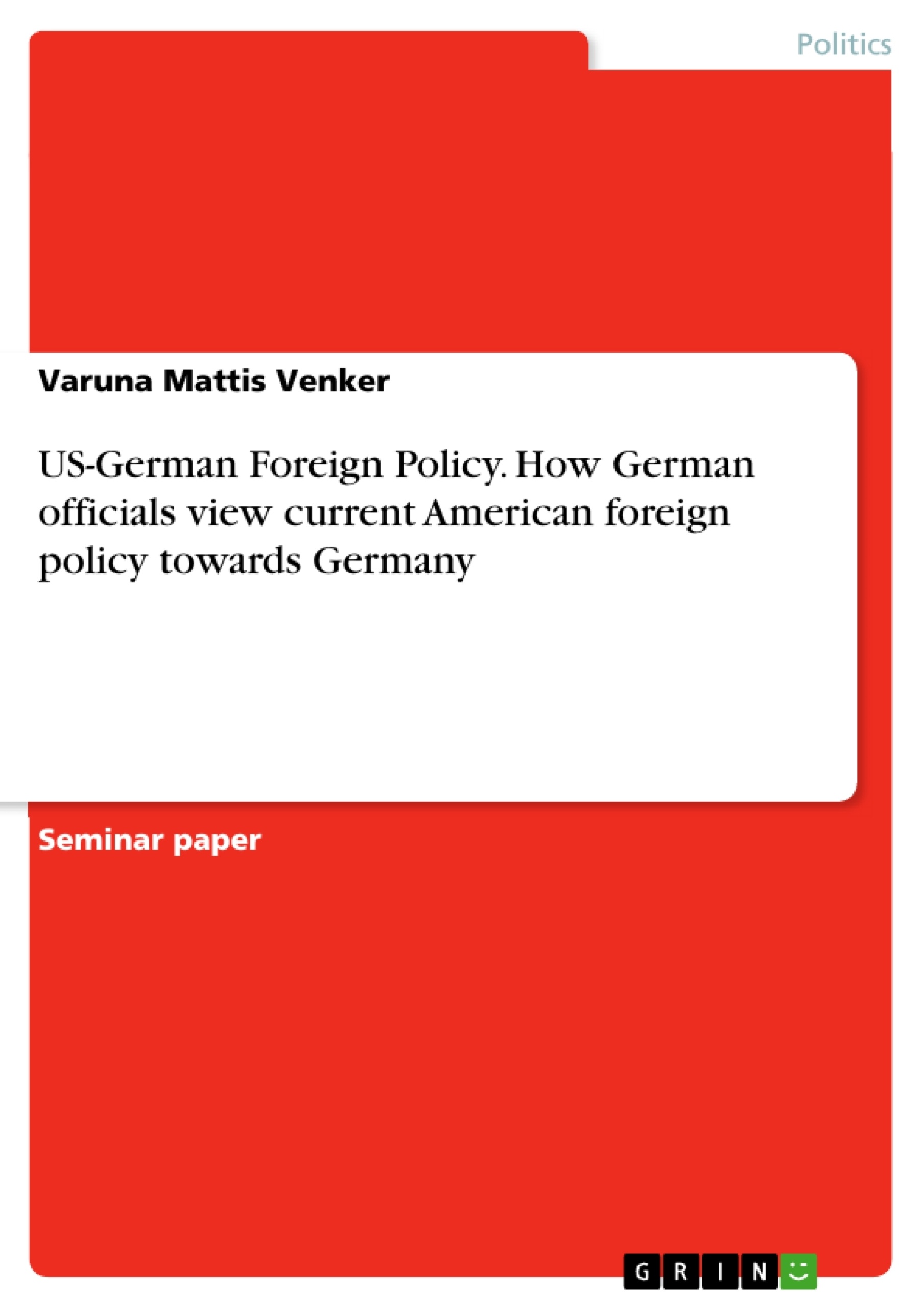This paper deals with the question of how German officials view current American foreign policy towards Germany.
Before I begin to analyse the German view on current American foreign policy, I will give a little sum up of how relations between Germany and the United States have developed since the 17th century. It began when Germans emigrated to the “New World“ and now they concern many contacts in the cultural, economic, scientific, political and military fields.
How German officials view current American foreign policy towards Germany
HISTORY
Before I beginn to analyse the German view on current American foreign policy I will give a little sum up of how relations between Germany and the United States have developed since the 17th century. It begann when Germans emigrated to the “New World“ and now they concern a large number of contacts in the cultural, economic, scientific, political and military fields.
German immigration began in the 17th century and Germans were involved in the founding of Jamestown as early as 1607. In 1683 Franz Daniel Pastorius founded "Germantown" near Philadelphia together with the English Quaker William Penn. At that time, German immigrants came mainly from Baden, Württemberg, Hesse and the Palatinate as well as from the dioceses of Cologne, Osnabrück, Münster and Mainz.
At the beginning of the 18th century, economic problems in Germany led to a new wave of immigration to the USA. In 1709 alone, 13,000 willing emigrants from the devastated Palatinate met in London in the hope of a free passage (Piltz, 1975, p.16). Between 1717 and 1732, around 3,000 Mennonites moved to North America (Von Schlachta, 2009, p.427). Many descendants of the emigrated Palatinate people still speak with the Pennsylvania Dutch today a language variant based mainly on Palatinate dialects, which they call "Mudderschbrooch", "Pennsylvania Deitsch" or simply "Deitsch". When the American War of Independence broke out in 1775, 250,000 Germans were already living between Maine and Georgia (Piltz, 1975, p.17).
When the borders and ports were free again after the coalition wars, over six million German emigrants came to America between 1820 and 1920. Almost a million Germans came to the United States around 1850 alone, including thousands of political refugees as a result of the 1848 revolutions in Europe (Piltz, 1975, p. 33). They were called Forty-Eighters. During this phase of German immigration, the newcomers joined the settlers who had previously emigrated from Germany. This “chain migration” phenomenon enlarged the existing German settlement areas. Towards the end of the 19th century, the Germans formed the largest group of immigrants.
The American isolation policy after the First World War and the economic crisis of the 20s led to a restriction on immigration permits. Even when many Germans turned their hopes on the USA during the Nazi era, the economic depression forced this restriction. Only prominent emigrants, especially artists and scientists, managed to enter the USA without major problems.
Today around 58 million Americans describe themselves as of German descent. In numerical terms, Germans are most strongly represented in California, followed by Pennsylvania, Ohio, Illinois and Texas. The largest German-American population density is found in the so-called "German Belt", which includes the states of Wisconsin, Minnesota, North Dakota, South Dakota, Nebraska and Iowa.
GERMAN-US-AMERICAN RELATIONS
As shown in this brief outline of their long relationship, there is a close friendship between Germany and the United States of America. It is based on historically grown relationships, shared experiences, values and interests.
The relationship with the USA is described by the German Foreign Office as follows:
As in the last few decades, close transatlantic coordination to maintain peace and security in Europe and around the world remains important for the great challenges of our time. The United States is a key partner in dealing with the social and economic consequences of the COVID-19 pandemic as well as global challenges such as climate change and strengthening the multilateral order.
The transatlantic security community within the framework of NATO and the around 34,000 US soldiers stationed in Germany contribute to the security of Europe.
The close economic relationships also create jobs and exchange in Germany and the USA. The USA was the largest buyer of German exports in 2020, Germany is the USA's most important trading partner in Europe.
[...]
- Arbeit zitieren
- Varuna Mattis Venker (Autor:in), 2021, US-German Foreign Policy. How German officials view current American foreign policy towards Germany, München, GRIN Verlag, https://www.grin.com/document/1163245
-

-

-

-
Laden Sie Ihre eigenen Arbeiten hoch! Geld verdienen und iPhone X gewinnen. -

-
Laden Sie Ihre eigenen Arbeiten hoch! Geld verdienen und iPhone X gewinnen. -

-
Laden Sie Ihre eigenen Arbeiten hoch! Geld verdienen und iPhone X gewinnen. -

-
Laden Sie Ihre eigenen Arbeiten hoch! Geld verdienen und iPhone X gewinnen. -

-
Laden Sie Ihre eigenen Arbeiten hoch! Geld verdienen und iPhone X gewinnen.

